Bootstrap is the most popular CSS framework ever. It is currently used on over 19.7% of all sites on the web, and despite the rapid rise in popularity of front-end JavaScript frameworks, it continues to grow. And with each new version (currently v5), it gets better and better.
Built on a mobile-first grid system, bundled with an endless list of components, utilities and helpers, and the fact that it is easy to customize and extend, it is no wonder that web designers and developers continue to use and love Bootstrap. It truly is the perfect framework for quickly getting started on any web project.
To help make life easier for you, we have collected forty of the best free Bootstrap 5 templates for you to use on your next project. We have purposefully omitted all of those starter and barebones templates from this collection, of which there is already a multitude available on the web. Instead, we have focused on highlighting all of those fully-featured, beautifully designed, and, of course, free Bootstrap templates that you can use straight away.
All of the responsive templates come packaged with pre-styled ‘ready to use’ components, and many have been bundled with additional extras, like charting libraries, pricing tables, tabs, and much more. These templates will save you hours of extra work and are waiting for you to add your content and creativity.
If you’re new to Bootstrap, the best place to learn how to use the framework is to follow the steps on the official quick start guide, and you’ll be up and running in no time.
You might also our collections of Bootstrap Admin templates and Bootstrap UI kits.
Bootstrap Portfolio Templates
These free Bootstrap portfolio templates have been designed for creatives to display their work. They include galleries, project showcases, and bio sections.
Style Bootstrap Template
Free to Download
This elegant and minimally designed free Bootstrap template includes a filterable portfolio, smooth slider, and many other useful web elements.

Lendex Bootstrap 5 Personal Portfolio Template
Lendex is the perfect foundation for building your portfolio. Built using Bootstrap 5, it comes packaged with multiple page layouts and sections, so you can develop and design your portfolio exactly how you need it.

Kross Single-Page Portfolio Template
Free to Download
Kriss is a bold, single-page portfolio template that seamlessly uses smooth scrolling to link the beautifully designed sections. This Bootstrap template could be used as a portfolio, resume, or as the homepage of a small agency.

Andle Bootstrap 5 Portfolio Web Template
Andle is an excellent Bootstrap 5 web template for creatives and design agencies. It comes with eight different page layouts and has been designed in an elegant modern style.

Barts Bootstrap Portfolio Website
Free to Download
Built using Booststrap, Barts is a super-simple web template for quickly creating a personal portfolio or resume site.

Creative Portfolio Bootstrap 5 Template
Free to Download
Built for both creatives and small businesses, this Bootstrap 5 template features a modern design and layout, and offers just enough to help get your website up and running quickly.

Bootstrap Landing Page Templates
These Bootstrap landing page templates focus on lead generation and conversions. They offer a single, focused goal, whether promoting an event, product, or service.
DevConf Free Bootstrap 5 Conference Template
Free to Download
DevConf is a free Bootstrap 5 single-page template for building the landing page of a technology or web development conference.

Qexal Bootstrap 5 Landing Page Template
The Qexal Bootstrap 5 web template comes bundled with nine different homepage layouts and multiple other page templates, such as services, pricing, blog, contact, and more. This Bootstrap template is the perfect foundation for launching any business.
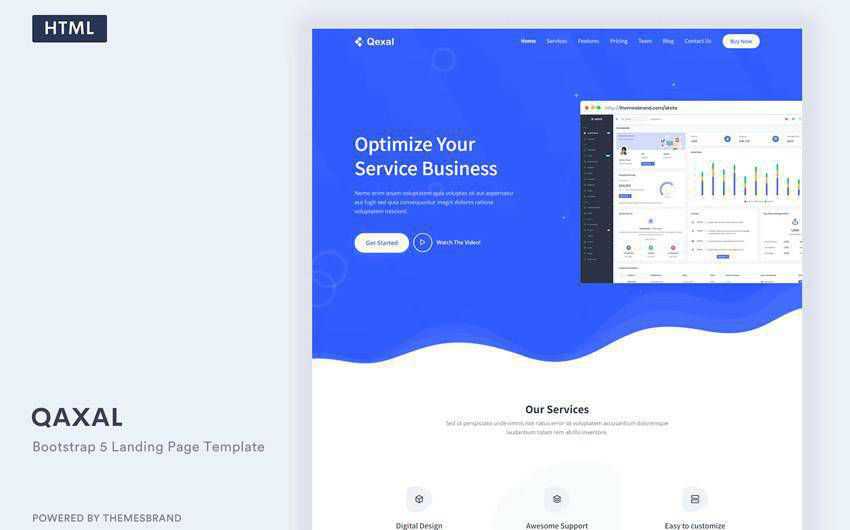
Simple Landing Page Bootstrap Template
Free to Download
You can’t get simpler than this free Bootstrap template. It has one single purpose: to allow you to build a landing page for your new products or services quickly. As well as the landing page layout, Simple also comes with an about, blog, and testimonial page templates.
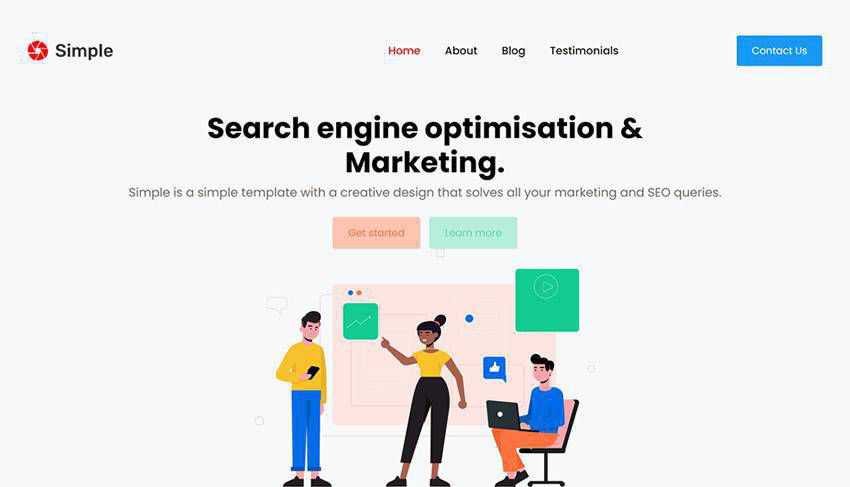
Peyso Bootstrap 5 Landing Page Template
The beautifully designed Peyso is a Bootstrap 5 web template for startups and businesses. It comes with six different homepage layouts and three authentication pages.
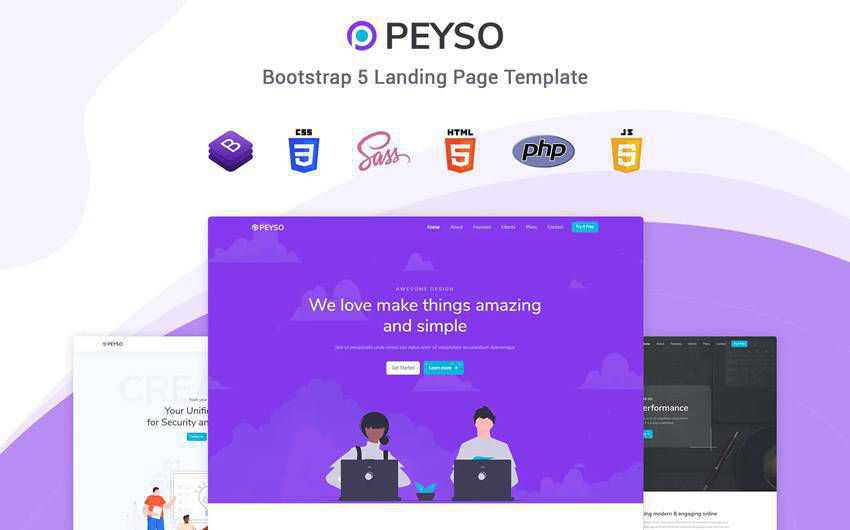
DevBook Bootstrap 5 Book & eBook Landing Page Template
Free to Download
DevBook is a minimally designed Bootstrap 5 landing page template for promoting or selling books or ebooks. It comes with all the components needed to convert visitors into buyers.
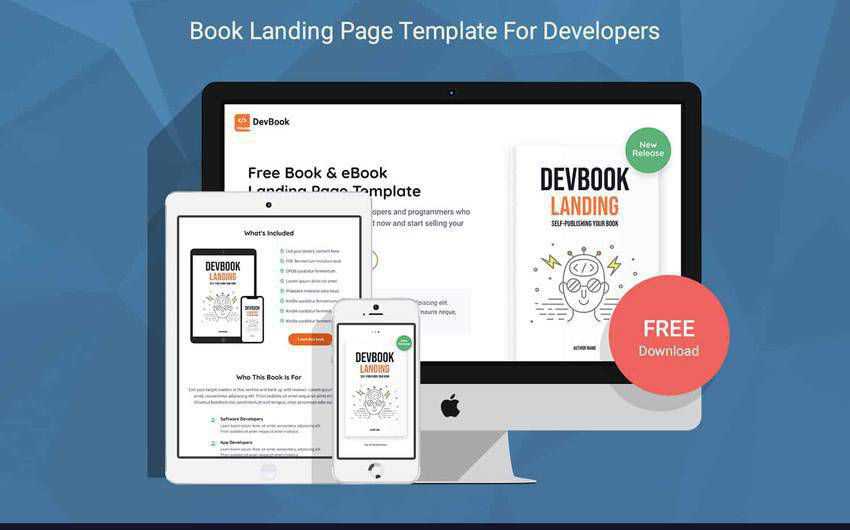
Agency One-Page Bootstrap 5 Template
Free to Download
Agency is a single-page template that has recently been updated to Bootstrap 5. It is perfect for design agencies or small businesses that need to set up a basic landing page.

AppKit Landin Page Template
Free to Download
Built on Bootstrap 4, AppKit is a free landing page template for helping you launch and promote any product or service.

Simple Bootstrap 5 Landing Page
Free to Download
This simple Bootstrap 5 template comes with all the essential features you need to quickly build a landing page for showcasing your products or apps.

eCommerce Bootstrap Templates
These eCommerce templates offer layouts for showcasing products, handling shopping carts, and processing transactions. These free Bootstrap templates will give you a user-friendly shopping experience while maintaining a professional appearance.
Safia Bootstrap 5 eCommerce Bootstrap Template
Free to Download
This bold, dark, and minimally designed Bootstrap 5 landing page template could be used to promote or launch any service or product. It would be perfect for a start-up or a single-product eCommerce store.
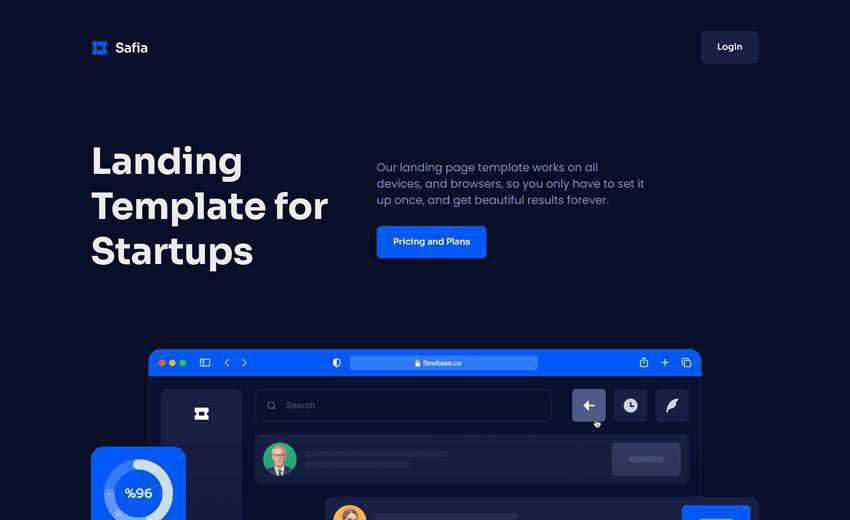
Alan Kitchen Bootstrap 5 eCommerce Template
This Bootstrap 5 eCommerce template comes bundled with multiple homepage, store page, product page, and blog page layout templates. It may be too extensive for smaller stores, but you could cherry-pick the needed pages and components.
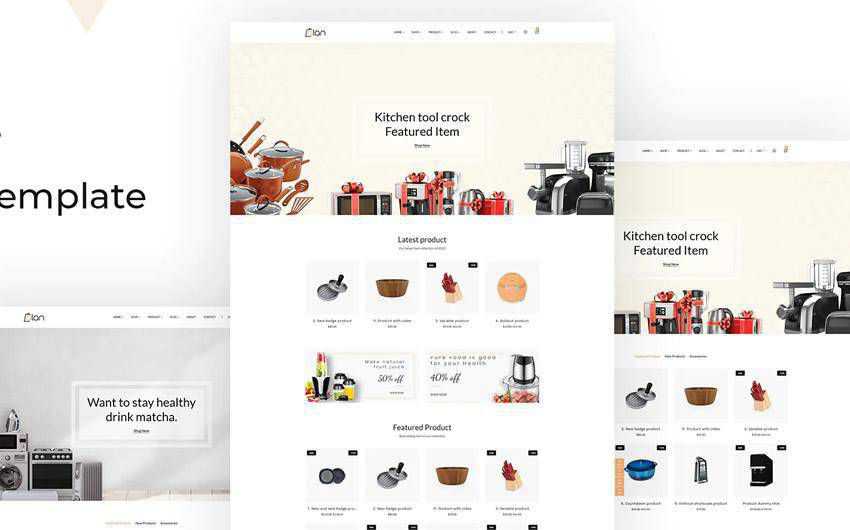
Majestic Bootstrap 5 eCommerce Template
Free to Download
Majestic is a clean Bootstrap 5 web template for eCommerce websites. It only comes with a homepage template, but if you’re an experienced web designer, you can easily create a multi-page site by cleverly repurposing using the many beautifully designed homepage sections.

Shop Homepage Bootstrap 5 Template
Free to Download
This unstyled Bootstrap 5 template is the perfect foundation for building a modern eCommerce website. There are just enough features to help you get started quickly.
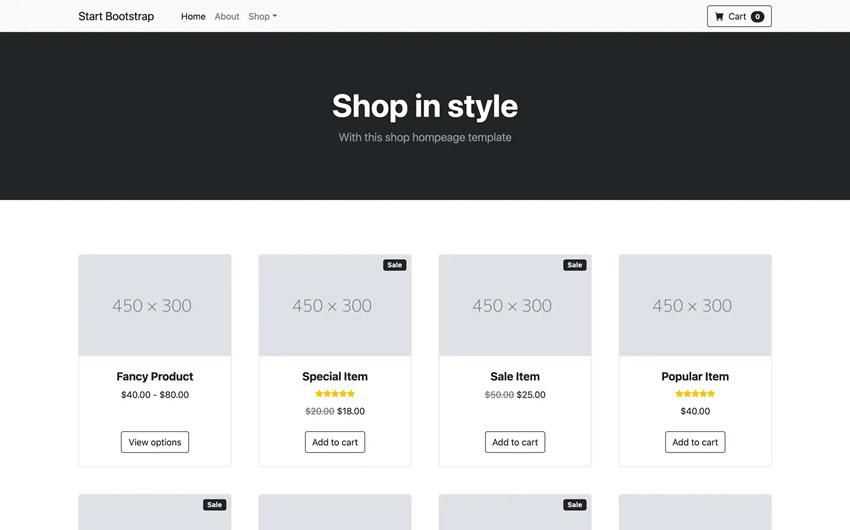
Business Bootstrap Templates
Bootstrap business templates for creating corporate websites and professional services. They include sections for company information, team members, services, and contact details.
Promodise Bootstrap Business Template
Free to Download
This Bootstrap template comes bundled with multiple homepage layouts (including a single-page layout) and templates for about, services, pricing, blog, and contact pages. This flexible and easy to edit template could be used as the homepage of any business.

Zinc Bootstrap 5 Business Web Template
Free to Download
Zinc is a clean Bootstrap 5 web template for small businesses. It comes with various page layouts, but it works best as a smooth-scrolling single-page layout.
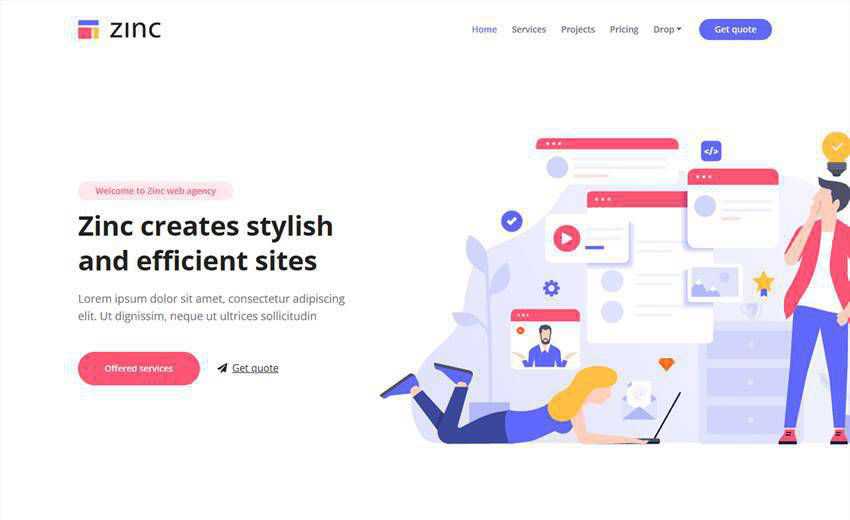
CoderDocs Bootstrap 5 Documentation Template
Free to Download
Built for developers, CoderDocs is an open-source Bootstrap 5 documentation template. Its modern design and simple layout make it easy to customize to suit any project.
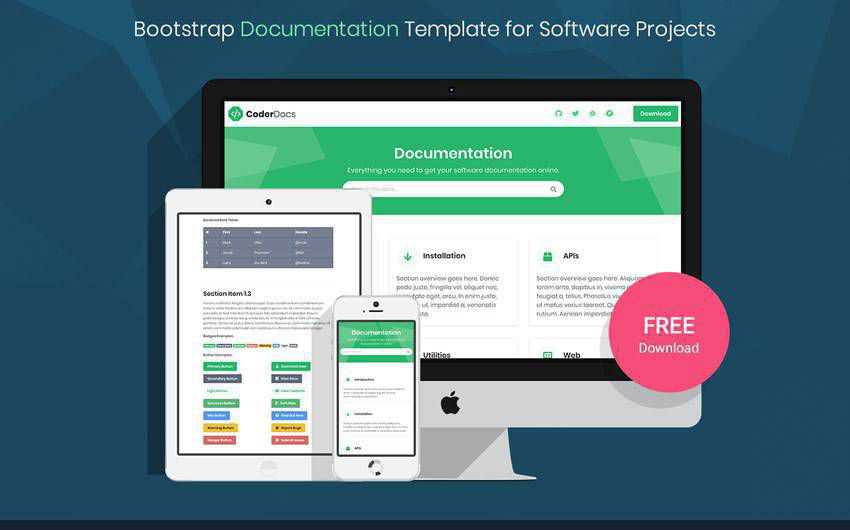
Small Business Bootstrap 5 Template
Free to Download
This template is an unstyled, barebones Bootstrap template for quickly building a small business website. It has recently been updated to Bootstrap 5.
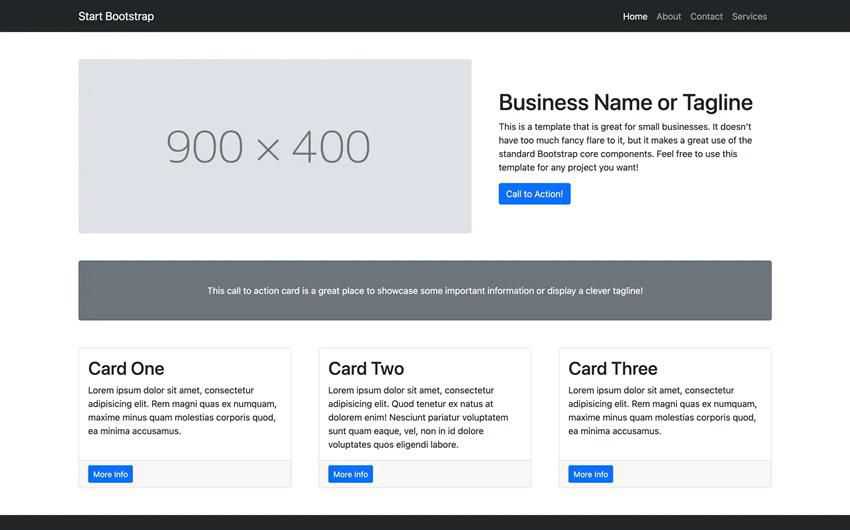
Space Business Bootstrap 5 Template
Free to Download
Space is a simple one-page Bootstrap 5 template for small businesses. It features a clean design and flawless, smooth scrolling between each of the homepage’s sections.

Jadoo Bootstrap 5 Travel Agency Web Template
Free to Download
Even though this template has been marketed as a travel agency template, it could easily be used as the homepage of many types of websites. It has a beautiful hero header section, sticky navigation bar, services section, smooth animated hover interactions, and much more.

Little Squirrel Bootstrap 5 Education Template
Free to Download
Little Squirrel is a clean multi-page Bootstrap 5 template for education and learning websites. In addition to a multi-section homepage layout, the free template also includes course selection, pricing, and blogging templates.

Bunzo Bootstrap 5 Blogging Template
The Bunzo Bootstrap 5 web template comes with everything you need to build a modern blog your readers will love. The bundled layout templates gives you the flexibility to create the blog or online magazine you need.
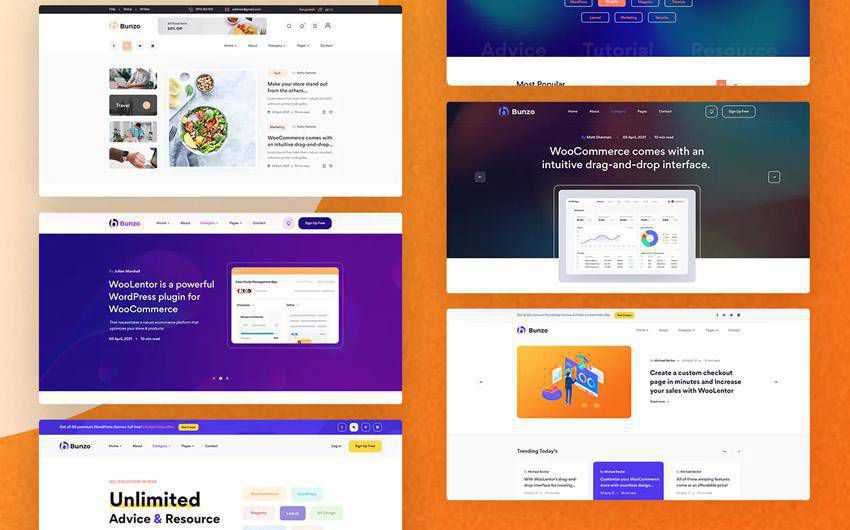
Bootstrap Single-Page Templates
With these single-page Bootstrap templates, all of your content is presented on one continuous page. This is ideal for minimalist websites or personal profiles.
Swipe One-Page Bootstrap 5 Template
Free to Download
Swipe is a simple Bootstrap 5 template for quickly building a homepage or landing page for mobile applications. It also features a testimonial, FAQ, and downloads section.
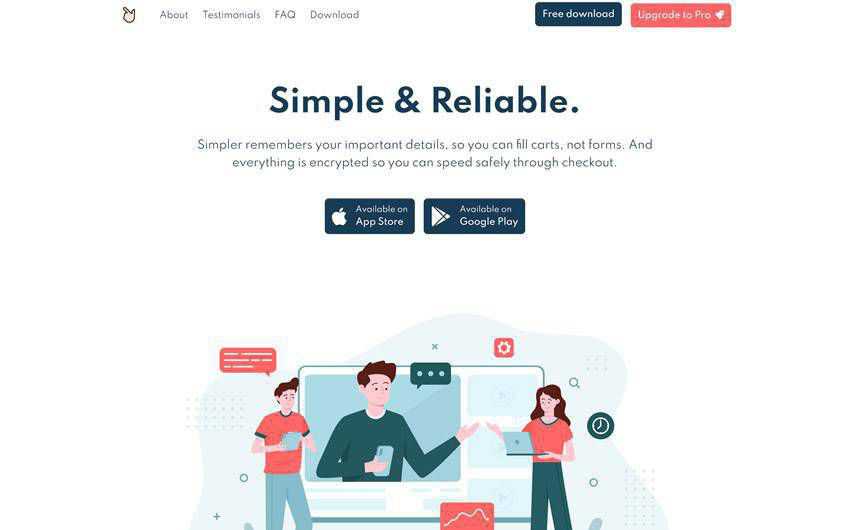
Brushed One-Page Bootstrap Template
Free to Download
Brushed is a beautifully designed single-page Bootstrap template for design studios and agencies. It could also be the perfect template for creatives looking to build a portfolio quickly.

Mamba One-Page Bootstrap 5 Template
Free to Download
Recently updated to Bootstrap 5, Mamba is a multi-purpose one-page template designed for various types of businesses.
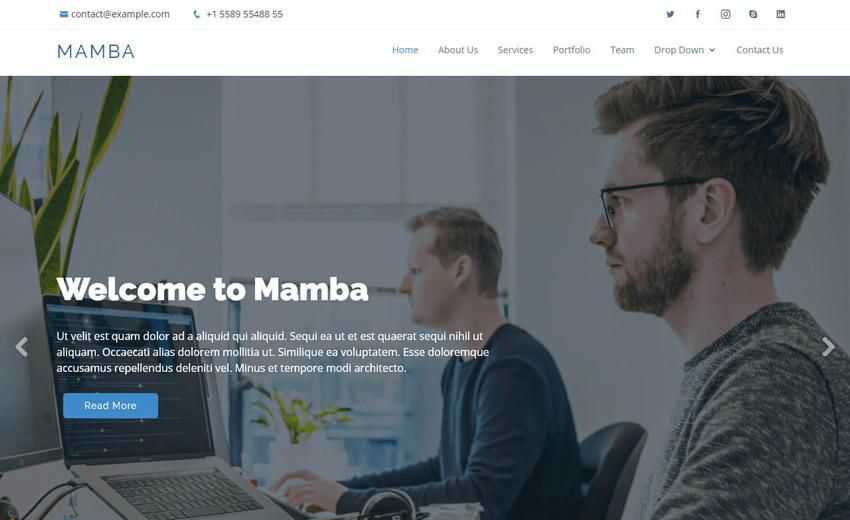
Grayscale Single-Page Bootstrap 5 Template
Free to Download
Recently updated to Bootstrap 5, Grayscale is a multi-purpose, one-page web template with a dark layout and smooth scrolling page animations.

Freelancer One-Page Bootstrap 5 Template
Free to Download
Designed using the flat design aesthetic, Freelancer is a one-page template that allows developers to create a portfolio or resume site quickly.

Bootstrap Multi-Purpose Templates
These multi-purpose templates include various layout options and customizable components, suitable for many different types of websites. These all offer flexibility.
Scout Multi-Purpose Bootstrap Template
Free to Download
Due to its clean design and simple layout, Scout is a Bootstrap template that could be used on many different types of sites. Easy to edit and build upon, this template comes with all of those useful web components you would expect from a professional template.
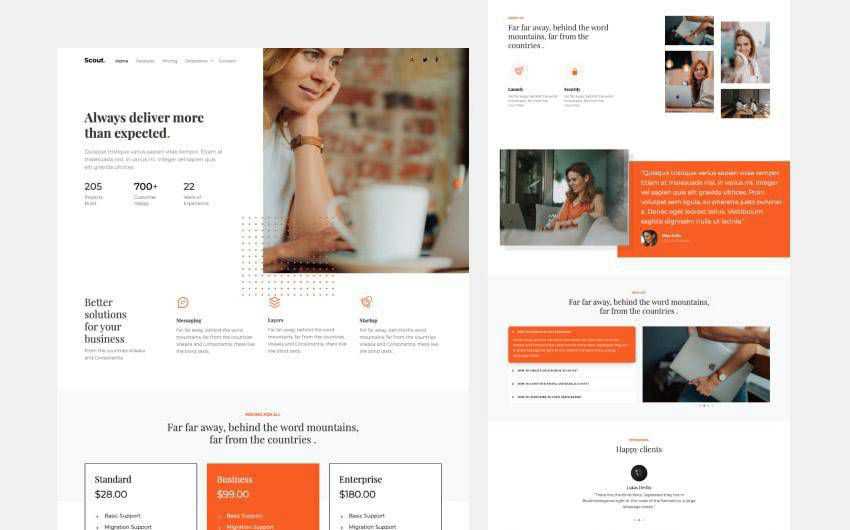
Knight One-Page Multi-Purpose Bootstrap 5 Template
Free to Download
Multi-purpose in design, the Knight Bootstrap 5 template is an excellent foundation if you want to build a single-page business site quickly.

Mountain King Multi-Purpose Template
Free to Download
The Mountain King Bootstrap Template has a clean and responsive layout and includes Typicons vector icons, masonry galleries, off-canvas menus, and smooth CSS animations.
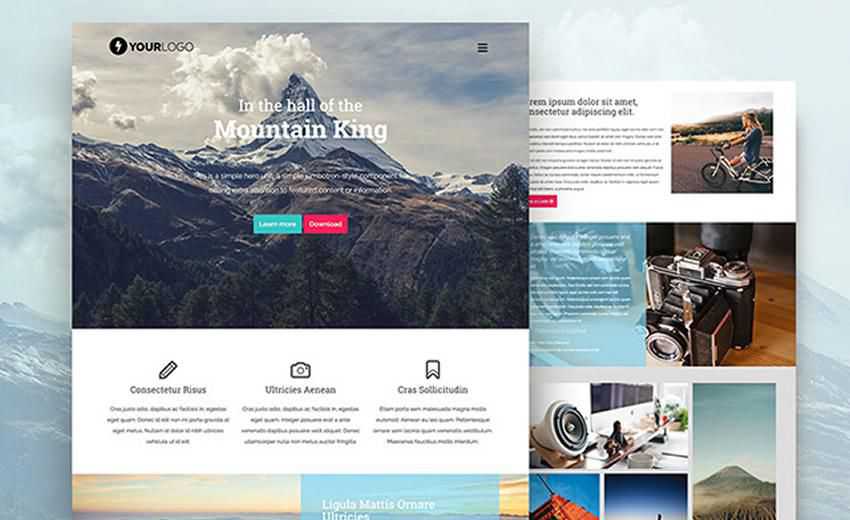
Bootstrap Design Agency Templates
These Bootstrap design agency templates are tailored for agencies needing to showcase portfolios, case studies, and client testimonials.
K!sbag Minimal Agency & Portfolio Template
Free to Download
K!sbag is a clean Bootstrap template that comes with six pre-built page layouts, including homepage, blog, about, contact, portfolio, and single project page. It could be used as either a personal portfolio or a design agency website.

Strane Startup Agency Bootstrap 5 Template
With its fifteen various HTML layout templates and super-simple design, Strane is the ideal Bootstrap 5 template for creating a startup or business website.

Avana Design Agency Template
Free to Download
Avana is a modern Bootstrap template built for design agencies or personal portfolios. It features a smooth-scrolling homepage and a user-friendly blogging section, and its beautiful typography perfectly complements it.

Amoeba Design Agency Bootstrap 5 Template
Free to Download
Amoeba is a simple one-page Bootstrap 5 template for design agencies. It features an about us, services, portfolio, team, and contact us sections.

Coming Soon Bootstrap Templates
These coming soon templates are perfect for pre-launch pages. They include countdown timers, subscription forms, and placeholders for essential contact information. These free templates help build anticipation and collect user interest before you launch your new website.
Coming Sssoon Bootstrap Page Template
Free to Download
Ssssoon is a simple landing page template for anyone who needs to quickly create a basic coming soon page for their new website. This template allows you to choose either an image or video background.
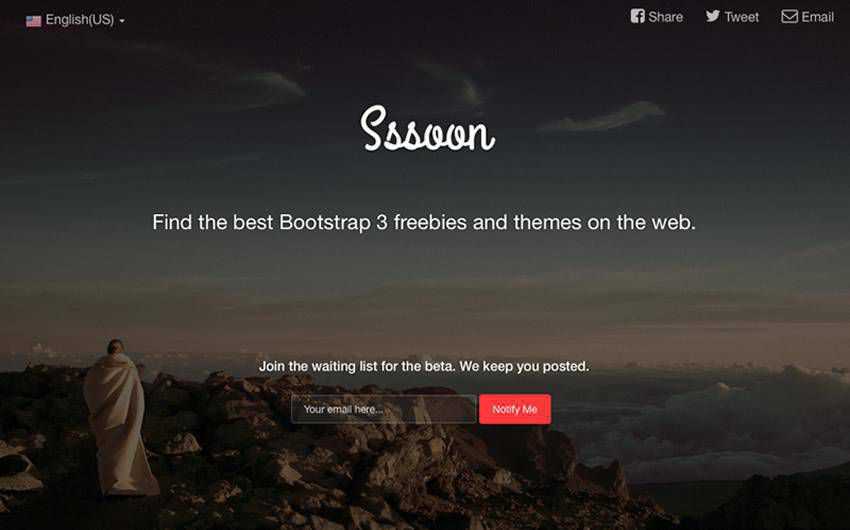
Maundy Coming Soon Bootstrap 5 Template
Free to Download
This simple Bootstrap 5 coming soon template features a countdown timer and an about section for adding information about your business. It has just enough features to get your coming soon page online quickly.

Material Design Templates
These free Bootstrap templates incorporate Google’s Material Design principles. They emphasize bold graphics, grid-based layouts, and responsive animations.
Material Design for Bootstrap 5
Free to Download
The Material Design Bootstrap 5 template allows you to use Google’s Material Design specs in your favorite front-end framework. The template includes 500+ Material UI components.
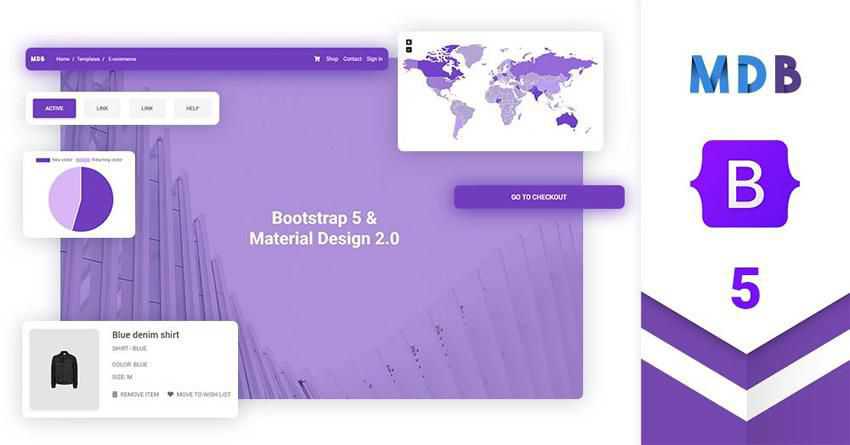
Bootplus Front-End Framework
Free to Download
Bootplus is a front-end framework for faster and easier development. Google’s UI has inspired its design.
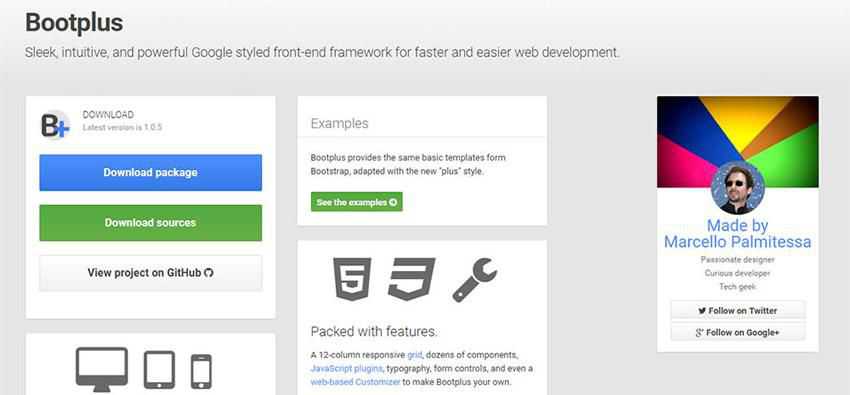
Nostalgic Bootstrap Templates
NES-style CSS Framework
Free to Download
If you’re a fan of vintage video games, then you’ll love this free Bootstrap theme. NES.css allows you to give your websites a nostalgic 8bit-like look and feel.

Bootstrap/386 DOS Web Template
Free to Download
Carrying on with nostalgia, with this free Bootstrap template, you can make your web pages look like vintage DOS computers from the 1980s.

Windows 95/98 Bootstrap Template
Free to Download
Jumping forward from the 1980s, we’re now going to take a step into the 1990s. Win95.CSS is a free template that allows you to build incredible websites that look like the GUI from Windows 95 and 98.
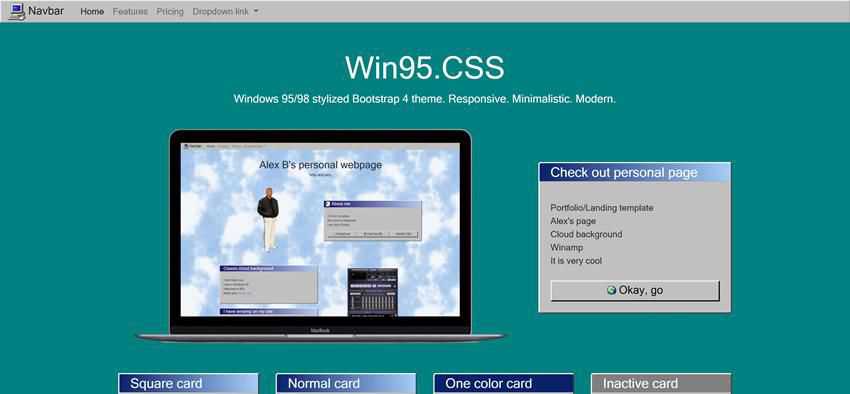
Geo for Bootstrap
Free to Download
This time, we’re stepping back into the early days of the web. Do you remember how websites looked back then? Not pretty at all. Geo is a free template that will allow you to recreate that look. I’m not sure why you would want to do that, but it’s a fun project all the same.
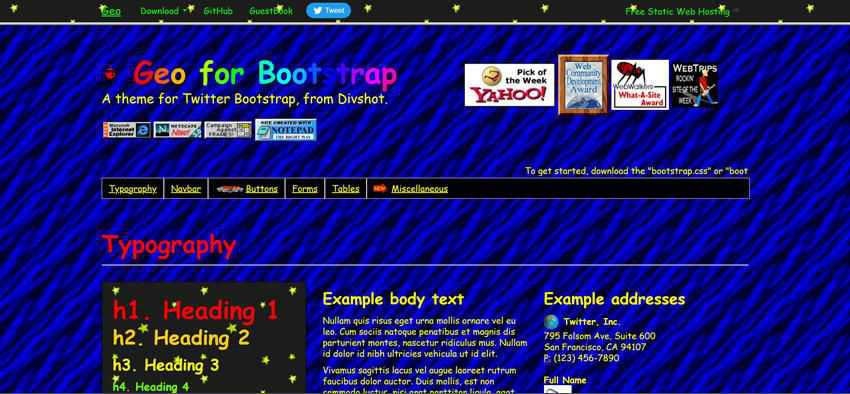
Bootstrap Template FAQs
-
What is Bootstrap?Bootstrap is a free and open-source framework for creating websites and web applications. It’s full of UI components for building responsive and mobile-first web projects using CSS, HTML, and JavaScript.
-
Why Use Bootstrap Templates?Bootstrap templates offer ready-made designs and layouts for your web projects. They save time, ensure responsive design, and provide a professional look without starting from zero.
-
Do I Need Coding Skills to Use Bootstrap Templates?Knowledge of HTML, CSS, and some JavaScript is helpful, but many templates are user-friendly with detailed instructions, making them accessible even if you’re not a coding expert.
-
How Customizable are Bootstrap Templates?They’re highly flexible. The level of customization varies across different templates.
-
Are Free Bootstrap Templates Reliable for Serious Projects?Most free templates are robust and reliable for various projects. However, it’s good practice to review the template’s updates and community feedback for long-term reliability.
-
Can I Use These Bootstrap Templates for Commercial Purposes?Often, yes, but it’s important to check the licensing agreement for each template. Most free Bootstrap templates can be used in both personal and commercial projects, while others have restrictions.
-
What Features Do Free Bootstrap Templates Usually Include?Bootstrap templates often come with features like responsive navigation bars, image sliders, contact forms, and various UI components. The exact features depend on the specific template you choose.
-
How Often Are These Templates Updated?It varies. Some template developers regularly update their templates to fix bugs and add new features, while others may not. Always check the update history for the latest information.
-
Are There Any Limitations to Using Free Bootstrap Templates?While free templates offer many benefits, they might not be as unique or as customizable as premium ones. Also, some templates might lack certain advanced features or dedicated support.
-
Can I Combine Different Bootstrap Templates for One Project?Yes, you can mix and match elements from different Bootstrap templates. However, be mindful of potential style and script conflicts when combining templates from different sources.
More Free UI Resources
Related Topics
Top